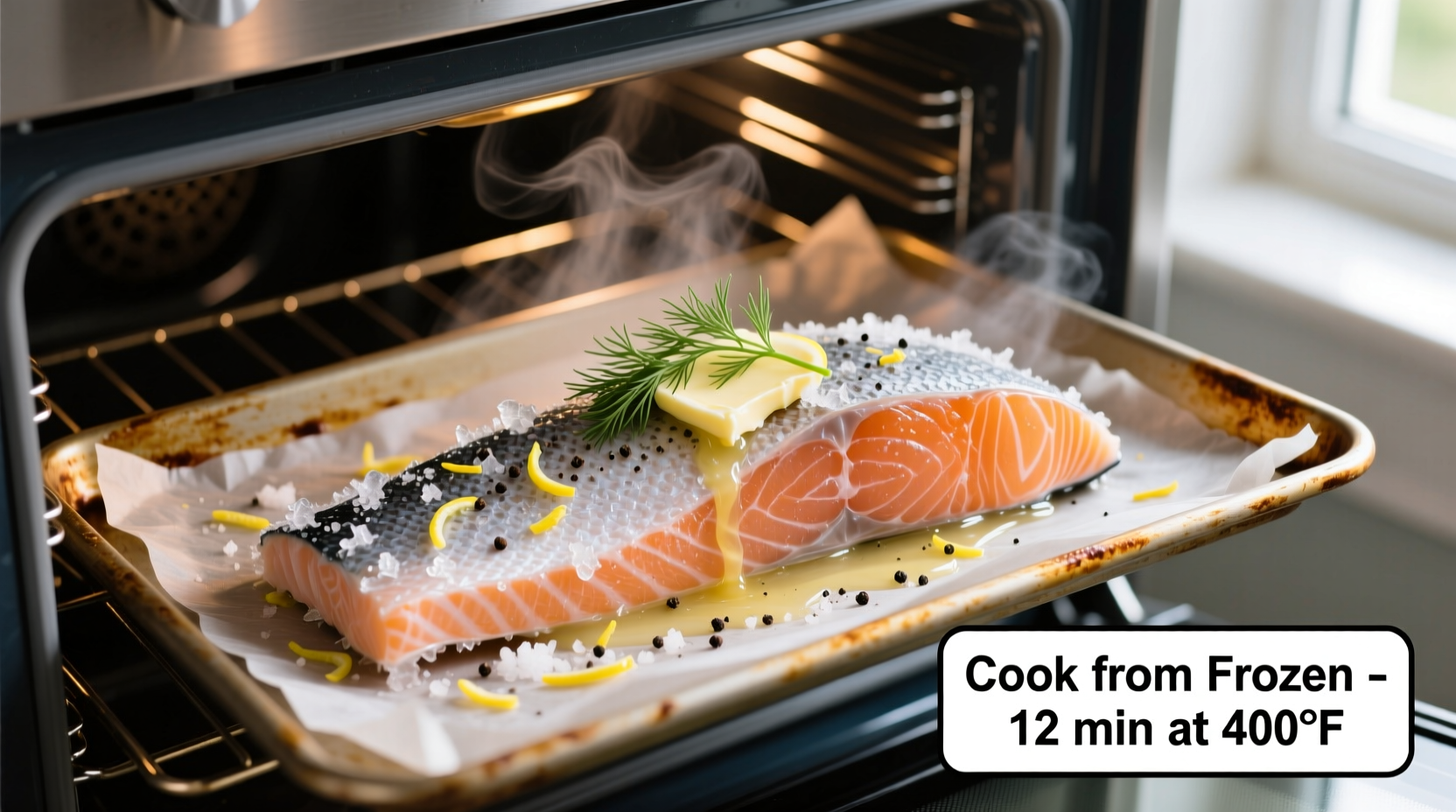Why Skip the Thaw? The Science Behind Frozen Salmon Cooking
Most home cooks waste valuable time thawing salmon when they don't need to. Modern food science confirms that cooking salmon directly from frozen preserves moisture better than thawed-and-cooked methods. The gradual temperature change prevents the protein fibers from contracting too quickly, which typically squeezes out moisture in traditionally thawed fish. According to USDA Food Safety guidelines, cooking frozen fish is perfectly safe as long as you reach the proper internal temperature of 145°F (63°C).
Your Frozen Salmon Cooking Toolkit
Before you begin, gather these essential items:
- Oven preheated to 400°F (204°C)
- Baking sheet with parchment paper or aluminum foil
- Instant-read thermometer (critical for food safety)
- Olive oil or melted butter for moisture retention
- Simple seasoning blend (salt, pepper, garlic powder)
Step-by-Step: From Freezer to Feast in 20 Minutes
Preparation Phase: Setting Up for Success
Remove salmon from packaging and rinse briefly under cold water to remove any ice crystals. Pat the surface dry with paper towels—this crucial step prevents steaming and promotes proper browning. Place fillets skin-side down on your prepared baking sheet, leaving space between pieces for even air circulation. Lightly brush with oil or melted butter and season simply; complex spice rubs can burn during the extended cooking time required for frozen fish.
Cooking Process: Precision Timing Matters
The exact cooking time depends on your salmon's thickness. Here's a reliable reference guide based on USDA Food Safety Inspection Service recommendations:
| Salmon Thickness | Starting Temperature | Recommended Cooking Time | Internal Temperature Target |
|---|---|---|---|
| 1 inch (2.5 cm) | Frozen (-18°C/0°F) | 15-18 minutes | 145°F (63°C) |
| 1.5 inches (3.8 cm) | Frozen (-18°C/0°F) | 18-22 minutes | 145°F (63°C) |
| 2 inches (5 cm) | Frozen (-18°C/0°F) | 22-25 minutes | 145°F (63°C) |
Insert your thermometer into the thickest part of the salmon at the 12-minute mark. Continue checking every 2 minutes until it reaches 145°F. Remember that salmon will continue cooking from residual heat after removal from the oven, so pull it out when it reaches 140°F for perfect doneness.

Avoiding Common Frozen Salmon Mistakes
Many home cooks encounter issues when cooking frozen salmon. Here's how to prevent the most frequent problems:
When This Method Works Best (and When to Thaw Instead)
This no-thaw method excels with standard portion-sized fillets up to 1.5 inches thick. For specialty preparations, consider these context boundaries:
- Best for: Weeknight dinners, simple preparations, skin-on fillets
- Avoid for: Stuffed salmon, very thick cuts (over 2 inches), or recipes requiring precise searing before oven finishing
- Special note: If your salmon has been frozen longer than 6 months, thawing first may yield better texture as extended freezing causes more ice crystal formation
Texture Troubleshooting Guide
If your salmon turns out dry despite following timing guidelines, you've likely encountered one of these common issues:
- Over-seasoning before cooking: Salt draws out moisture from frozen fish. Apply salt in the last 5 minutes of cooking
- Incorrect oven rack position: Place salmon in the middle rack for even heat distribution
- Poor thermometer placement: Ensure the probe isn't touching the baking sheet which reads hotter than the fish
Elevating Your Frozen Salmon Results
While cooking from frozen saves time, these professional techniques enhance flavor and presentation:
- Finish under the broiler for 60-90 seconds for beautiful caramelization without overcooking
- Rest cooked salmon tented with foil for 5 minutes before serving to redistribute juices
- Create a quick pan sauce using the flavorful drippings from the baking sheet
- Pair with bright, acidic sides like lemon-dressed arugula to balance the rich fish
Frequently Asked Questions
Can I cook frozen salmon without drying it out?
Yes, by using higher oven temperatures (400°F/204°C) for a shorter time period and monitoring internal temperature carefully. The key is removing salmon at 140°F as carryover cooking will bring it to the safe 145°F target.
Do I need to adjust seasonings when cooking frozen salmon?
Absolutely. Avoid salting frozen salmon before cooking as it draws out moisture. Instead, apply salt during the last third of cooking time. Dry spice rubs should be used sparingly as they can burn during the extended cooking period.
Is it safe to cook salmon from frozen according to food safety standards?
Yes, the USDA confirms cooking fish directly from frozen is safe as long as it reaches 145°F internally. This method actually reduces the risk of bacterial growth compared to improper thawing methods left at room temperature.
Why does my frozen salmon sometimes have white foam during cooking?
This harmless albumin protein is pushed out as the fish cooks. It's more prevalent in frozen fish due to ice crystal formation. To minimize it, cook at higher temperatures and avoid overcooking.











 浙公网安备
33010002000092号
浙公网安备
33010002000092号 浙B2-20120091-4
浙B2-20120091-4